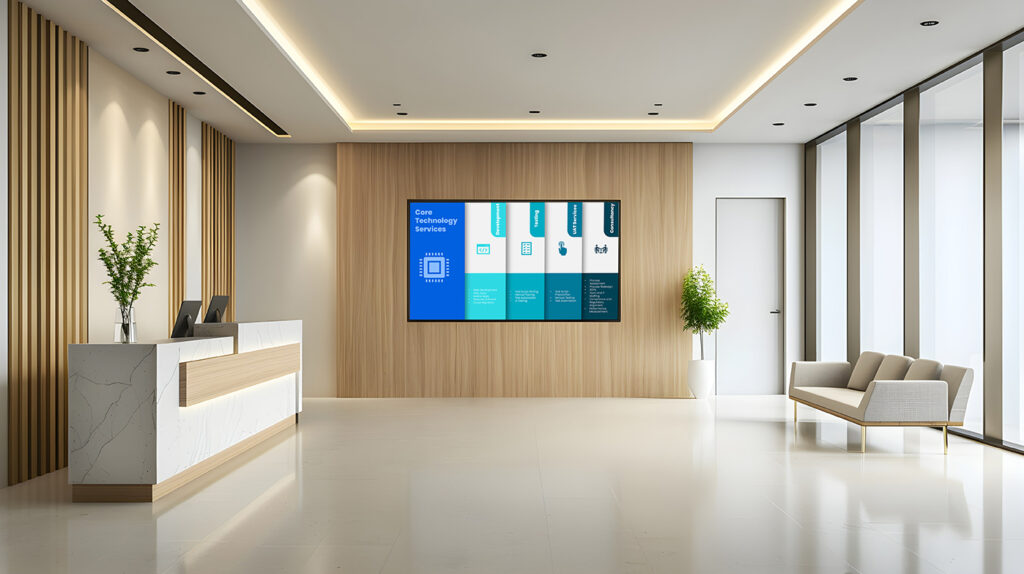Have you ever wondered why, while waiting in the hospital waiting room, you watch the endless slideshow displayed on the rectangular screens perched above the hospital reception? What about the hospital’s infographics on diseases, medical services offered, and advice on precautions pull you in?
You could just as readily engage your mind elsewhere. Yet, you continually find your gaze returning to the rectangular screens and the visuals splayed across them. That is the power of self-running presentations.
Self-running presentations or auto-play presentations are presentations that advance automatically without manual input or a guiding speaker.
They are a formidable business tool, serving as a silent yet persuasive brand ambassador.
After all, you now know all about the hospital’s medical services and public health initiatives- thanks to the self-running presentation at the reception.
Self-running presentations are more than slides on a screen; they are a powerful marketing and branding tool. They ensure your message reaches the right audience, even in your absence.
They provide continuous exposure, reinforce brand messaging, and capture audience attention in high-traffic areas without requiring a speaker. They are a cost-effective way to advertise, engage audiences, strengthen brand identity, deliver key messages, and influence decisions.
A well-designed self-running presentation can enhance brand credibility, attract potential customers, and educate audiences effectively.
But how can you design a self-running presentation that captures attention, effectively conveys key messages, and leaves a lasting impact without verbal explanation?
Here are our top tips for designing a stellar self-running presentation:
Define Your Core Message
Defining the core message, objective and purpose of the presentation beforehand is essential. This clarity will guide your presentation’s content, visuals, and design process cohesively. Ask yourself these three questions:
- Will this presentation inform, persuade, or inspire?
- What is the key takeaway for my audience?
- How can I make this message memorable?
Since self-running presentations compete with distractions, clarity and brevity are essential. Every slide should contribute meaningfully to the overall narrative.
Effectively Structure Your Content
A well-structured presentation follows a logical flow while telling a story. Divide your content into the following parts:
- Introduction: Reel your audience with a compelling hook, such as a thought-provoking question, statistic or story.
- Main Body: Present your key points in a structured way. Ideally, you should limit yourself to three to five main ideas. Supplement your key points with real-world examples, data, and storytelling to enhance understanding.
- Conclusion: Summarise your key points and findings. Look to the future and leave your audience with a call to action or a thought-provoking statement.

Prioritise Visual Appeal
A self-running presentation is only as effective as its design. Since viewers process visuals faster than text, optimising design elements is crucial. To ensure your presentation is visually appealing:
- Use minimal text and more visuals. Replace long paragraphs with high-quality images, icons, and infographics.
- Have a consistent theme. Use cohesive and consistent elements that align with your branding guidelines.
- Ensure the readability of fonts & sizes. Opt for sans-serif fonts like Arial or Montserrat and keep text large (24pt or more for key points).
Leverage Interactive & Engaging Elements
Since self-running presentations play in the absence of a speaker, engagement must come from the content itself. Make your presentation dynamic by using the following interactive and engaging tools:
- Looping Videos & GIFs: Short, looping visuals maintain interest and reinforce messages.
- Infographics & Data Visualizations: Present statistics and figures in a digestible format.
- Subtle Motion Effects: Use movement to direct attention without overwhelming the viewer.
- Live Polls & Quizzes: If interactive options are available, do include live polls and quizzes in your self-running presentations.
Use High-Impact Slide Transitions
In the absence of a guiding speaker, transitions can guide attention and maintain engagement without being distracting. Ensure you employ:
- Subtle animations to avoid excessive effects
- Smooth transitions to create a polished flow
- Emphasise key points with motion effects or bold typography.
Optimise for Maximum Clarity
Clarity is non-negotiable in presentations, especially for one without a presenter. Keep these best practices in mind to optimise for maximum clarity:
- Use The 6×6 Rule: No more than six words per line, six lines per slide.
- Follow A Logical Flow: Ensure the narrative of your presentation follows a straightforward sequence.
- Avoid Clutter: Ensure your slides are clean and visually organised.
- Test For Readability: View your presentation from different distances to ensure legibility.
- Ensure Seamless Looping: A self-running presentation should transition smoothly from the last to the first slide without jarring breaks. The presentation must look like an undisturbed endless loop.
Finish with a Lasting Impression
End your presentation with a memorable conclusion and a strong call to action. Our formula is to summarise key takeaways, direct the audience toward the next steps and leave them with a thought-provoking question. Effective self-running presentations often conclude with:
- A call to action (e.g., ‘Visit our website for more information’).
- A powerful statement or question to leave viewers thinking.
- Branding elements like logos, taglines, and social media handles.
Our 10 Essential Rules for Self-Running Presentations:
- Define your key message and objective upfront.
- Keep content concise and avoid unnecessary details (use strong visuals to replace excessive text).
- Ensure consistent branding with colours, fonts, and logos.
- Limit slides to one key idea per frame.
- Use the 6×6 rule (no more than six words per line, six lines per slide.)
- Use high-resolution images and professional design elements.
- Incorporate smooth transitions and animations sparingly.
- Test for readability across different screen sizes.
- Ensure the presentation loops seamlessly for continuous engagement.
- End with a compelling call to action.
Branding and design specialists like Dolphin Branding know that self-running presentations enhance brand awareness, educate viewers, and influence decision-making effortlessly. By ensuring your message reaches your audience even in your absence, self-running presentations shape audience perceptions and business success.
That’s why we combine strategic content, visually engaging design, and a seamless user experience to create presentations that inform and leave a lasting impression.
Let’s make your next self-running presentation unforgettable!
Drop us an email at contact@dolphinbranding.in to help us help you elevate your brand today.



Comments are closed